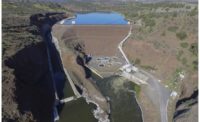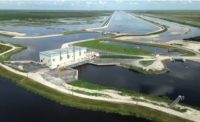A three-year clock on the initial development of a 2.2-GW pumped-hydro energy storage project on Lake Powell near Page, Ariz., has started following the issuance of preliminary permit by the Federal Energy Regulatory Commission
The permit gives Daybreak Power Inc priority rights to further study and develop the proposed $3.6-billion Navajo Energy Storage Station, says James Day, CEO of developer Daybreak., owner of Navajo Energy Storage Station LLC.
“We are shooting for start of operations around 2030, with licensing complete around 2026,” Day says. At that time, Daybreak will be close to final investment decision, with contracts for long-term offtake, EPC firm, vendors and detailed engineering.
He is now “informally working” with engineering firm Worley and expects to formalize that arrangement, with Worley as owner’s engineer.
Project Elements
The project will be typical for a pumped-hydropower plant—powerhouse, turbines, tunnel, upper reservoir, penstocks. An 18-mile-long, 500-kV transmission line will interconnect with the existing switchyard of the Navajo Generating Station, a 2.25-GW coal-fired power plant shut down in November 2019. That station provided electrical power to California, Nevada and Arizona. The Navajo Energy Storage Station plans to serve those markets’ storage needs using the coal plant’s 230-kV transmission system.
The upper reservoir, to be constructed on Navajo Mountain in the Navajo Nation, will have 18,600 acre-ft of estimated usable volume impounded by a rockfill concrete-face dam 15,150 ft long, with a maximum height of 131 ft.
The powerhouse will be built on the Cummings Plateau overlooking the lake, with eight variable-speed pump turbine generating units with a combined 2.21-MW capacity providing 10 hours of continuous generation.
A 6,550-ft-long water conveyance structure between the reservoirs will include a 35-ft-dia headrace tunnel, eight penstocks, eight draft tubes and two 31-ft-dia tailrace tunnels. The hydraulic head for generation will be 1,350 ft.
Lake Powell was formed as a reservoir on the Colorado River in 1966 when Glen Canyon Dam was completed to help ensure an equitable distribution of water between the states of the Upper Colorado River Basin and the Lower Basin. A region-wide drought since 2000 has caused its elevation to decline, so the intake must be below the lake’s minimum surface elevation. “We will design water intake well below current levels and most likely into ‘deadpool,’ ensuring that as long as Glen Canyon Dam exists we will be able to operate,” Day says.
But WildEarth Guardians is intervening in the permit process. “One of the problems with this project is that it denies the impacts of climate change on Lake Powell,” says Jen Pelz, wild rivers program director. “The Colorado River’s average annual flow has already decreased 20% since 2000 and is set to lose 20-55% by 2100. Climate change alone is going to make it extraordinarily difficult for Lake Powell to continue to operate as it has historically.” Further, she says, “The ability to generate hydropower ceases below 3,490 ft elevation. Some models indicate that levels in Lake Powell could approach this elevation by 2023.”
Navajo Energy Storage Station LLC’s preliminary permit application claims the impact of withdrawing 18,600 acre-ft on the water levels of Lake Powell would be negligible. Pelz counters, “This is the argument every water user makes, but does not take into account the cumulative impacts of that withdrawal from the system.”




Post a comment to this article
Report Abusive Comment